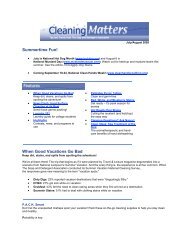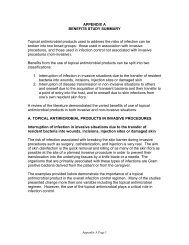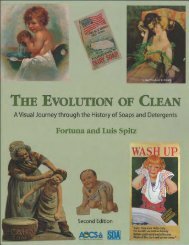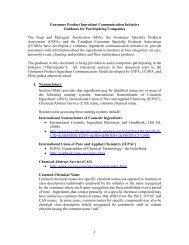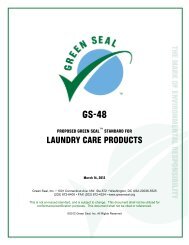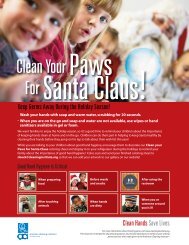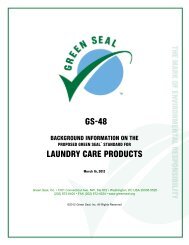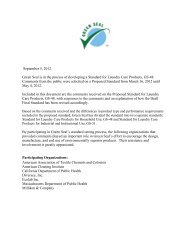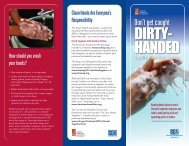subchapter c -- federal hazardous substances act regulations
subchapter c -- federal hazardous substances act regulations
subchapter c -- federal hazardous substances act regulations
You also want an ePaper? Increase the reach of your titles
YUMPU automatically turns print PDFs into web optimized ePapers that Google loves.
16 CFR Ch. II (1–1–05 Edition) – proposed modification – 6/25/06<br />
rotate about a common axis or fastening point<br />
or otherwise move relative to one another; and<br />
(ii) Any coil springs which expand when<br />
the article is subjected to a force that will<br />
extend the spring to its maximum distance so<br />
that a space between successive coils is greater<br />
than oneeighth inch (0.125 inch) are covered<br />
or otherwise designed to prevent injuries; and<br />
(iii) All holes larger than one-eighth inch<br />
(0.125 inch) in diameter and slots, cracks, or<br />
hinged components in any portion of the<br />
article through which a child could insert, in<br />
whole or in part a finger, toe, or any other part<br />
of the anatomy are guarded or otherwise<br />
designed to prevent injuries; and<br />
(iv) The articles are designed and<br />
constructed to prevent accidental collapse<br />
while in use; and<br />
(v) The articles are designed and<br />
constructed in a manner that eliminates from<br />
any portion of the article the possibility of<br />
presenting a mechanical hazard through<br />
pinching, bruising, lacerating, crushing,<br />
breaking, amputating, or otherwise injuring<br />
portions of the human body when in normal<br />
use or when subjected to reasonably<br />
foreseeable damage or abuse; and<br />
(vi) Any article which is introduced into<br />
interstate commerce after the effective date of<br />
this subparagraph is labeled:<br />
(A) With a conspicuous statement of the<br />
name and address of the manuf<strong>act</strong>urer, packer,<br />
distributor, or seller; and<br />
(B) With a code mark on the article itself<br />
and on the package containing the article or on<br />
the shipping container, in addition to the<br />
invoice(s) or shipping document(s), which<br />
code mark will permit future identification by<br />
the manuf<strong>act</strong>urer of any given model (the<br />
manuf<strong>act</strong>urer shall change the model number<br />
whenever the article undergoes a significant<br />
structural or design modification); and<br />
(vii) The manuf<strong>act</strong>urer or importer of<br />
the article shall make, keep, and maintain for 3<br />
years records of sale, distribution, and results<br />
of inspections and tests conducted in<br />
accordance with this subparagraph and shall<br />
make such records available at all reasonable<br />
hours upon request by any officer or employee<br />
of the Consumer Product Safety Commission<br />
and shall permit such officer or employee to<br />
inspect and copy such records, to make such<br />
stock inventories as he deems necessary, and<br />
to otherwise check the correctness of such<br />
records.<br />
(5) Clacker balls described in §<br />
1500.18(a)(7) that have been designed,<br />
manuf<strong>act</strong>ured, assembled, labeled, and tested<br />
in accordance with the following requirements,<br />
and when tested at the point of production or<br />
while in interstate commerce or while held for<br />
sale after shipment in interstate commerce do<br />
not exceed the failure rate requirements of the<br />
table in paragraph (a)(5)(vi) of this section:<br />
(i) The toy shall be so designed and<br />
fabricated that:<br />
(A) Each ball: Weighs less than 50 grams;<br />
will not shatter, crack, or chip; is free of<br />
cracks, flash (ridges due to imperfect<br />
molding), and crazing (tiny surface cracks);<br />
and is free of rough or sharp edges around any<br />
hole where the cord enters or over any surface<br />
with which the cord may make cont<strong>act</strong>. Each<br />
ball is free of internal voids (holes, cavities, or<br />
air bubbles) if the balls are made of materials<br />
other than those materials (such as ABS<br />
(acrylonitrile butadiene styrene), nylon, and<br />
high-imp<strong>act</strong> polystyrene) that are injectionmolded<br />
and possess high-imp<strong>act</strong><br />
char<strong>act</strong>eristics.<br />
(B) The cord: Is of high tensile strength,<br />
synthetic fibers that are braided or woven,<br />
having a breaking strength in excess of 445<br />
Newtons (100 pounds); is free of fraying or<br />
any other defect that might tend to reduce its<br />
strength in use; is not molded in balls made of<br />
casting resins which tend to wick up or run up<br />
on the outside of the cord; and is affixed to a<br />
ball at the center of the horizontal plane of the<br />
ball when it is suspended by the cord. Clacker<br />
balls where the mass of each ball is less than<br />
12 grams (0.42 oz.) and the distance between<br />
the center of the pivot and the center of the<br />
ball cannot exceed 180 mm (7.1 inches) may<br />
have a minimum cord breaking strength of less<br />
than 445 Newtons (100 pounds), as computed<br />
by the following formula:<br />
Adjusted Cord Breaking Strength in<br />
Newtons=0.1382(mb) (Rp), where mb=mass<br />
of a single ball in grams and<br />
Rp=pivot length in mm.<br />
(C) When the cord is attached to the ball by<br />
means of a knot, the end beneath the knot is<br />
chemically fused or otherwise treated to<br />
-- 74 --



